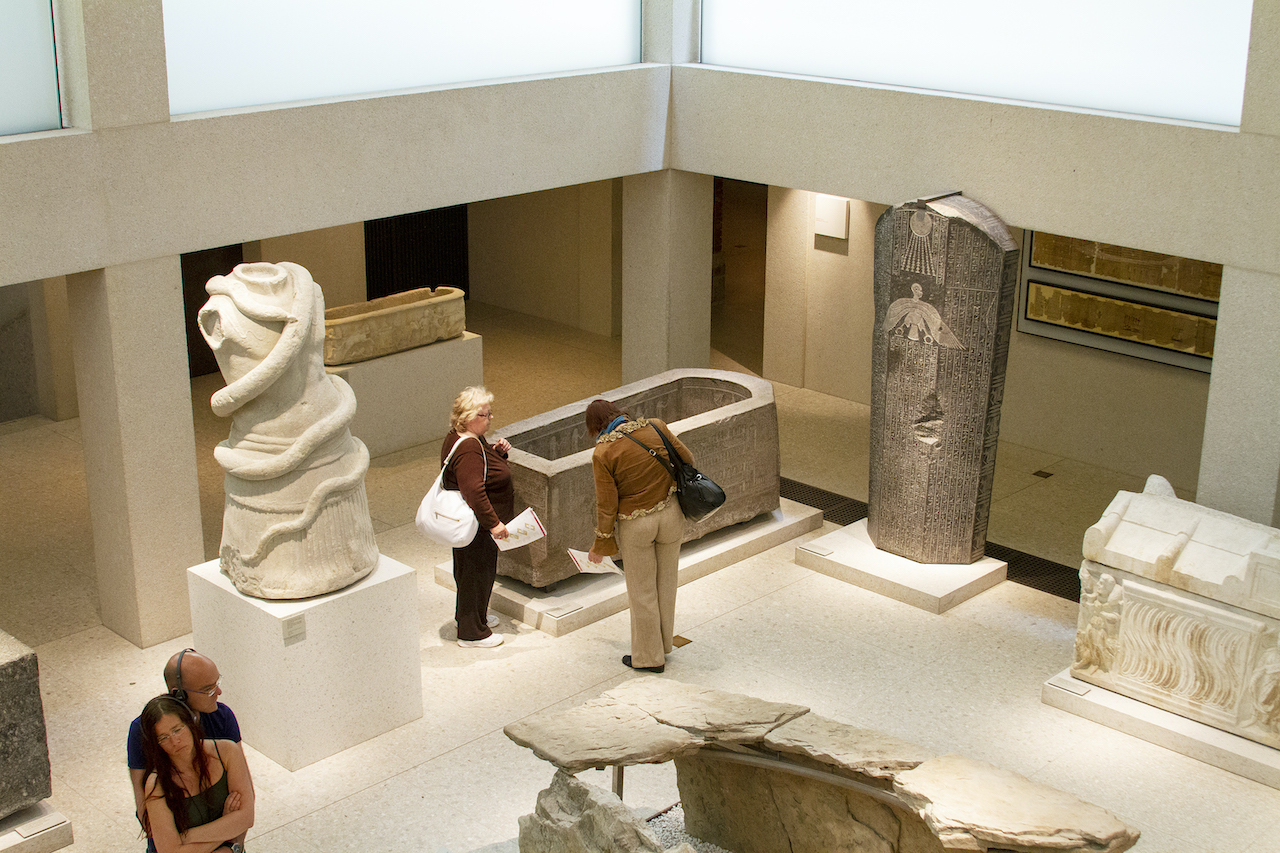Contents
- Holding the Line: Notes from Walking the Picket Line with the Burgerville Workers Union
- Where’s the Drop?: Notes on Dance Music Ecologies
- Counting Presence
- Here’s Sax Beat
- Walking in dissidence: reckoning with stability and moral aestheticism in Odland and Auinger’s “Harmonic Bridge”
In this issue’s cover image—a still from artist Dave McKenzie’s video piece “Old Man/ Sarcophagus”—we observe some visitors in a Berlin museum through the lens of McKenzie’s camera, candidly interacting with ancient Egyptian artifacts. As McKenzie explains, ”young people would walk by, passing this historical fact and their mortality. Then I saw another older couple; the guy leaned on it, deeply looking into the place that bodies go. I started thinking about what these objects are and the strangeness of this old man needing it. Now he needs a little break, a little rest, and soon he, and all of us, will more or less be in some…thing.” What indeed is so compelling about these museum patrons, grasping, sometimes with their own casually outstretched arms, for some support, some stability of meaning amidst the curated ruins of history?
Stated simply, Soap Ear’s tenth issue is motivated by this kind of lingering curiosity about what the idea of “stability” can really do. Like many of you, we are all too aware of how appeals to norms, balance, and grace have and continue to drive neo-liberal rationalizations of inequality. But then, how and where might we—our communities and our selves—find moments of rest and of peace that counteract this capitalist hyperreality. What kinds of stability could actually serve us?
Our first two pieces in this issue—Abby Castillo’s “Holding the Line” and Ryan Clarke’s “Where’s the Drop”—focalize collective and communal processes through theoretical, scientifically informed perspective. Castillo writes evocatively of her experience picketing as a striking employee of the drive-through fast-food chain, Burgerville, borrowing concepts from cybernetics to illustrate the inner workings and affective experiences in both the strike and business-as-usual. Ryan Clarke, on the other hand, interrogates the metastable—that which is “practically stable” to our perception—within the realm of dance music. Clarke reflects upon the creative ecosystem that makes up communities and scenes, acknowledging that our desire to find stability can lead our scenes to accept less than adequate creative conditions as if they were stable and tenable in the long term. Both of these writers sense in ecology—in the biological give and take of resources and energies—, recourse to forgotten logics leading elsewhere than our present late capitalist heat death.
Next are two written elaborations upon creative process by artists who, in their work, seek stability through quite different structures. Daniel Corral documents the process and structure behind his sound and video piece, Count In, through which he offers a sustained experience of predictability and change as an alternative to the drama and consumptive overload of daily life. This is a spirit he traces from composer James Tenney, as he once elaborated in an interview with Donnacha Dennehy:
Like, all the old assumptions about how the form of the piece needs to be full of surprising, unexpected changes, keep you on the edge of your seat and stuff like that. And I’m just not interested in that. I’m interested in a form that as soon as you’ve heard a couple of minutes of it, you get a pretty good idea of what you’re going to hear later. (Tenney)
In a reflection on the creation of the album Sax Beat, Nick Flessa then reaffirms that change is inevitable and one response to capture that element of change is to simply put a structure or frame around it. By enforcing an almost arbitrary set of constraints—two sax and drum duos recorded a year apart in the same space for the same amount of time—Flessa finds a sense of creative freedom, an impetus to make a mark and leave behind an artifact.
In JFK Randhawa’s blazing and impressionistic critique of artists Odland’s and Auinger’s misguided public sonic installation outside MASS MoCA (Massachussets Museum of Contemporary Art), we finally return to the museum as a site situated within—while also simultaneously actively situating—countless contested histories. Without reducing Randhawa’s vision of the counter-publics unearthed in the crevices of these artists’ attempt at “urban renewal”, we will just leave you with a final provocation.
If we all have to rest on/in something sometime—on some hard surface—, how can we make that rest mindful? How do we find a kind of stability and decay that is personally, socially, and ecologically responsible. When did you last feel the kind of reprieve you need right now? Who and what got you there, and past there to this page? What comes after? If we must construct some sense of stability for ourselves, let’s find it and work through it in spaces fit for us: slowly but surely building our own coffin, just as we like it, here together.
Contents
- Holding the Line: Notes from Walking the Picket Line with the Burgerville Workers Union
- Where’s the Drop?: Notes on Dance Music Ecologies
- Counting Presence
- Here’s Sax Beat
- Walking in dissidence: reckoning with stability and moral aestheticism in Odland and Auinger’s “Harmonic Bridge”
Cover Image:
“Old Man/ Sarcophagus,” 2013
Single Channel HD Video with Sound
3:54 minutes trt
Edition of 5 + 1AP
Inventory #MCK143
Courtesy the artist and Vielmetter Los Angeles
